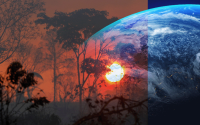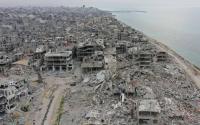 The extent of sea ice has been declining over the past 30 years |
Measurements made by the US National Snow and Ice Data Center (NSIDC) showed the extent of sea ice on 8 August was almost 30% below the long-term average.
Because the region's melting season runs until the middle of September, scientists believe this summer will end with the lowest ice cover on record.
Researchers have forecast ice-free summers in the Arctic by 2040.
NSIDC data showed sea ice extent for 8 August as 5.8 million sq km (2.2 million sq miles), compared to the 1979-2000 August average of 7.7 million sq km (3.0 million sq miles).
The current record low was recorded in 2005, when Arctic sea ice covered just 5.32 million sq km (2.09 million sq miles).
 |
"If you look at data for the first week in August, we are way below what we saw in 2005," explained Mark Serreze, a senior research scientist at the NSIDC.
"So unless something really changes, for example the Arctic suddenly becomes a lot colder, it is going to be hard not to beat the previous record."
Dr Serreze added that it was very likely that sea ice cover in the polar region was starting to respond to human induced climate change, resulting from a greater concentration of greenhouse gases in the atmosphere.
"We know that natural climate variability can strongly influence the sea ice, but I think we are starting to see a positive feedback now.
"In other words, we cannot explain everything that we have seen just through natural processes.
"Overall, the pattern will be that you melt a little bit more during the summer and you grow back a little less during the winter," he told BBC News.
Retreating ice
In December 2006, a study by US researchers forecast that the Arctic would be ice-free by 2040.
on error resume next flash2Installed = (IsObject(CreateObject("ShockwaveFlash.ShockwaveFlash.2"))) flash3Installed = (IsObject(CreateObject("ShockwaveFlash.ShockwaveFlash.3"))) flash4Installed = (IsObject(CreateObject("ShockwaveFlash.ShockwaveFlash.4"))) flash5Installed = (IsObject(CreateObject("ShockwaveFlash.ShockwaveFlash.5"))) flash6Installed = (IsObject(CreateObject("ShockwaveFlash.ShockwaveFlash.6"))) |
A team of scientists from the National Center for Atmospheric Research (NCAR), the University of Washington, and McGill University, found that "positive feedbacks" were likely to accelerate the decline of the region's ice system.
Sea ice has a bright surface that reflects 80% of the sunlight that strikes it back into space. However, as the ice melts during the summer, more of the dark ocean surface becomes exposed.
Rather than reflecting sunlight, the ocean absorbs 90% of it, causing the waters to warm and increase the rate of melting.
Scientists fear that this feedback mechanism will have major consequences for wildlife in the region, not least polar bears, which traverse ice-floes in search of food.
On a global scale, the Earth would lose a major reflective surface and so absorb more solar energy, potentially accelerating climatic change across the world.






